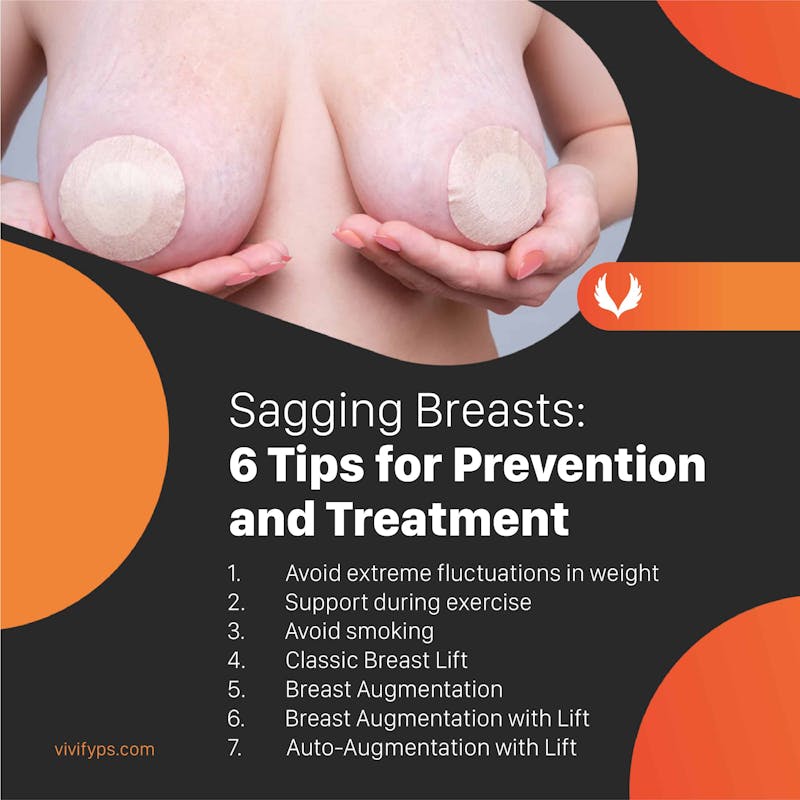
Sagging breasts, also known as ptosis, is a very common concern among women. Sagging breasts can cause women to feel less confident in their appearance and leave them feeling self-conscious about their bodies. Fortunately, we live in an age where there is no need to suffer
through the effects that lack confidence in our bodies can have on us!
Causes of Sagging Breasts
The causes of sagging in the breasts are plentiful. The first thing to understand about breast sagging is that It is a natural side effect of aging. Over time, gravity causes stretching of the ligaments of the breasts, and aging results in less hormone and collagen production. Those things in combination contribute to breast ptosis. In addition to this, many women experience significant changes in their breasts with pregnancy. Hormones and milk production causes the breasts to increase in volume. After pregnancy and breastfeeding, the breasts often return to their previous size, causing extra skin and leftover tissue that sags more than before pregnancy.
Another common cause of sagging breasts is weight fluctuations. Gaining weight causes more fat and tissue in the breasts. If the weight is lost, the fat and tissue in the breast go away as well, leaving the breast with less volume, often causing deflation of the breast skin and a more ptotic appearance to the breast.
Preventing Saggy Breasts
While sagging breasts are completely normal, there are several things you can do to slow the process down.
1. Avoid extreme fluctuations in weight.
The increase in fat and volume of the breast leads to Cooper’s ligament in the breast being stretched. When the volume in the breast decreases, the ligament remains stretched and leads to sagging. In addition to this, the elasticity of the skin on the breast is stretched in a similar way, causing it to break down and increase the appearance of sagging. Maintaining a consistent healthy weight can help avoid fluctuations which cause- elasticity breakdown and stretching of the ligaments and therefore can help prevent sagging.
2. Support during exercise
Repetitive movement of the breast tissue can cause sagging. While not wearing a bra during regular activity in your day to day routine has been proven to not be a cause of sagging breasts, the repetitive movement, such as the up and down while running, has been shown to cause strain on the ligaments and tissues of the breasts, leading to sagging. This can be avoided by wearing an appropriately fitting bra. The bra you choose should be tight enough to minimize extra movement while still being comfortable. There should never be discomfort associated with too tight of a fit, as this can cause further problems. However, too loose of a bra will not reduce movement.
3. Avoid smoking
Smoking has been proven to increase the effects of aging on the skin. This includes the breakdown of elasticity in the skin as well as the reduction in the levels of collagen. Smoking leads to fine lines and wrinkles on the face, neck, chest, and hands.
Treatment of Sagging Breasts
We live in a time where we can address and correct nearly any imperfection we see in our appearance. The same is true for sagging breasts. At VIVIFY plastic surgery in Tampa, there are several options to treat and prevent sagging breasts.
Classic Breast Lift
Mastopexy, better known as breast lift surgery, helps to correct sagging breasts by modifying the size, contour, and elevation of the breasts.
Recent polls have shown that breast lifts are quickly becoming one of the most popular cosmetic surgeries among women, even surpassing breast implants. Women are choosing breast lifts over breast augmentation because rather than desiring larger breasts, they simply
want to address breast sagging.
During a breast lift, the surgeon will lift and reshape your breast tissue by making an incision. The number and size of the incisions depend on several factors including the severity of the breast sagging.
There are typically three types of lift techniques that surgeons utilize for this surgery:
- The Benelli, donut lift, or periareolar technique lifts the breast tissue by making a small circular incision around the outer edge of the areola. This lift is a great option for minimal sagging.
- A vertical, or lollipop lift is a good option for women who have mild to moderate breast sagging and desire contouring or reshaping of breast tissue. Two incisions are made – one around the outer edge of the areola and another down the center of the breast.
- The anchor lift, also known as the “inverted T” lift, is ideal for moderate to severe cases of sagging. This technique uses the incisions of the lollipop lift and an additional horizontal incision along the natural breast crease.
Breast Augmentation
Another option for addressing breast sagging is a breast augmentation. This option is suitable for women who desire a larger breasts size overall. Implants are available in a multitude of sizes, shapes, and materials to help a patient look and feel their absolute best.
The most popular choice among implants is silicone. Patients prefer silicone implants because of the natural look and feel it provides.
Saline implants are another popular option because they can be less expensive than their silicone counterparts, placed through smaller incisions, and ruptures can be easily detected without the need for imaging.
Breast Augmentation with Lift
For women who wish to address sagging and increase the overall size of their breasts, a breast augmentation combined with a lift may be the best option. Women who choose this type of surgery are seeking elevation and fullness that a lift alone cannot achieve. Your plastic surgeon will have a consultation to determine if this is a suitable course of action for you.
Breast Auto-Augmentation with Lift
For women who want to achieve more fullness and improved shape to the breast, but want to avoid implants, an auto-augmentation may be an ideal option. For patients who have plenty of their own breast volume, but just not in the right places, the surgeon will manipulate the tissue and move it from a less desirable location to a more beneficial location to create increased fullness, shape, or projection. The surgeon may also support this tissue internally with soft tissue scaffolding (mesh) to prevent recurrent stretching over time.
Choosing the right plastic surgeon
When deciding which plastic surgeon in Tampa you will trust with your well-being and the results of your procedure, it is important to make sure you are considering only someone who is board-certified by the American Board of Plastic Surgery (ABPS). Board-certified surgeons spend a minimum of 6-8 years in training after medical school to ensure that they are well-trained in both aesthetic and reconstructive plastic surgery. Do not assume that another “cosmetic” or “aesthetic” surgeon is the same as a board-certified plastic surgeon.


